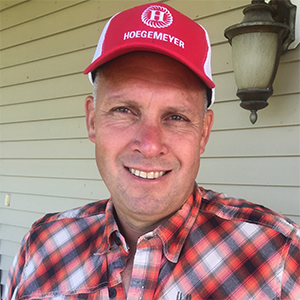Nebraska Farmer First in Line to Experience Enlist E3® Soybeans
Greg Hoegermeyer of Herman, Nebraska, has been keeping an eye on the Enlist™ weed control system. When several key import approvals for Enlist E3® soybeans came through in early 2019, he wanted to be at the front of the line to try them.
“I texted my Hoegemeyer Seed dealer and asked if I could get some Enlist E3 soybeans to try,” says Hoegermeyer, whose name is very close but not identical to that of the seed company he likes to do business with. Hoegermeyer says he likes the idea of using 2,4-D chemistry on soybeans postemergence.
“It should get the broadleaf weeds that are proving elusive for glyphosate,” he says. “It’s not supposed to be as volatile as other postemergence technologies, so I want to see how it works.”
Despite the nasty weather this spring, Hoegermeyer was able to finish planting and get the crop off to a decent start. After planting, Hoegermeyer came back with a preemergent herbicide program that included several modes of action. He plans to come back with postemergence applications including an Enlist herbicide – either Enlist Duo® herbicide which combines 2,4-D choline and glyphosate or Enlist One® herbicide tank-mixed with glyphosate to handle volunteer corn. He also may include Warrant and fomesafen to help handle waterhemp.
“Our biggest problem weeds are waterhemp followed by marestail,” Hoegermeyer explains. “The waterhemp appeared resistant to glyphosate last year. That’s one reason I wanted to try the Enlist system.”
Hoegermeyer is applying Enlist One herbicide – a straight-goods 2,4-D choline – on his Enlist E3 soybeans. He’s anxious to see what kind of weed control it will provide.
“I like the option to use glufosinate postemergence if needed,” he says. “We may do that in the future, but this year it’ll be Enlist One, Warrant and glyphosate.”
While the herbicide trait is important, it’s not the only aspect of Enlist E3 soybeans that Hoegermeyer will be judging. He wants to see if Enlist E3 varieties yield as well as the best varieties in the area.
“I want a variety to be agronomically sound,” he adds. “I want it to stand. I want disease resistance. It’s not just a single trait; we need the complete package.”
Hoegermeyer and his neighbors are communicating about the weed control traits and herbicides they’re using this year. Some neighbors are using different technologies, but they’re also curious to see how the Enlist herbicides perform.
“People generally feel there’s less risk with 2,4-D choline postemergence,” he says. “So they’re watching what we do.”
Hoegermeyer says he’s getting plenty of help to ensure he gets the most of the Enlist weed control system. His seed dealer and consultants are helping him access resources so he’s knowledgeable about applying Enlist™ herbicides.
“I’m spraying soon,” he says. “We should see the results in two weeks. I’m just waiting to see.” Many interested neighbors are waiting to see, too.
